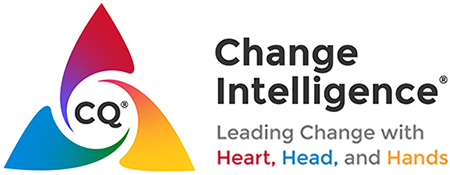What’s YOUR style of leading change?
Knowing your CQ (Change Intelligence) style can make all the difference for your ability to influence others and overcome resistance to change!
Just as each of us communicates, collaborates and handles conflict in our own unique ways, so do we each have our own style of leading change. And, just as we are much more effective in working with others when we understand ourselves and how we are similar and different than others – and can adjust accordingly – so we are much more confident and competent in influencing and partnering with others towards challenging goals when we understand the various change leader styles.
Our Change Leader style is comprised of our tendencies to lead with our Heart versus our Head versus our Hands. Powerful Change Leaders “start with the heart,” “engage the brain,” and “help the hands” move in positive new directions. Of course, none of us leads only, all the time, in every instance with the Head or Heart or Hands. We are each a blend of all three. It is this unique combination that represents our Change Leader Style.
There are seven possible styles, depending on how strong you are on heart, head and hands.
- If you’re a Coach, you’re all about Heart. You love engaging your colleagues whenever you get a chance, and you find great reward in supporting people around you as you all move through a change process.
- If you’re a Visionary, you are the one who’s always looking forward to an inspiring future. Thanks to your Head focus, you have a gift for seeing opportunity and planning for new situations, and you tend to get excited about what lies on the other side of a change.
- If you’re an Executer, you focus primarily on the Hands. You like to get things done, and people know they can rely on you to not just talk but take action. Often your execution is backed up by comprehensive, step-by-step plans.
- If you’re a Champion, you use a combined strength in Head and Heart to get people pumped about a change. Like a Visionary, you see abundant possibilities for the future and, adding the people skills of a Coach to the mix, you’re able to energize and excite your colleagues as you all work to bring about change.
- If you’re a Driver, you’re strong on both Head and Hands. You see an enticing vision before you, and you use your executional abilities to drive toward that vision, laying out clear strategies and tactics along the way.
- If you’re a Facilitator, you focus on specific people and specific activities you need to support on a day-to-day basis to lead the change, thanks to your strong Heart and Hands capabilities. You know the tasks that need to be accomplished to make measurable progress, and you succeed in motivating others to work together on those tasks.
- If you’re an Adapter, you’re about even on Head, Heart, and Hands. You can employ all three approaches as necessary, and you’re generally flexible, politically savvy, and willing to collaborate with others.
The relationship between the seven styles can be represented as a triangle, which, incidentally, is also the Greek symbol for change:

We enhance our influence and impact when we learn how to shift our leadership strategy to more meaningfully connect with people of different styles. We all know the Golden Rule, “do onto others as YOU want to be done unto.” To optimally partner with others through change, follow the Platinum Rule, “do onto others at THEY want to be done unto.”
Depending on the circumstances, sometimes we lead in one way and sometimes in another. No style is better or worse, right or wrong. However, at any given time one style may be more effective in leading change. Awareness of our style can help us adapt to different people and situations and ultimately take action to become more powerful change leaders.
By building Change Intelligence, Change Leaders are able to overcome what looks like resistance, but is really either confusion over the goal (no “Head”), lack of connection to the goal (no “Heart”), or lack of tactics and training to partner together to work toward the goal (no “Hands”). That’s CQ!
